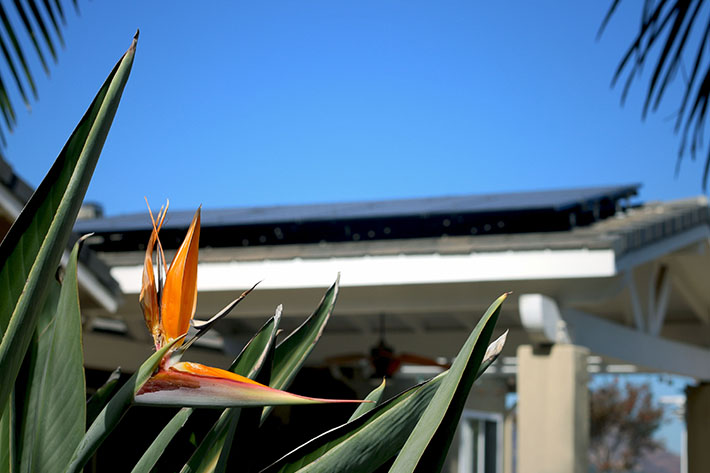
If you live in San Diego County, or you own and run a business here, you’ve probably heard a lot about solar power. Taking advantage of abundant sunshine, public support for clean energy, and the plunging costs of solar panels, the city of San Diego and its surrounding communities are vying to become a national hub of solar energy expertise.
That’s a good thing if you’re interested in solar panels for your home or business. It means your community has developed — and will continue to develop — sound knowledge about residential and commercial solar panel installation and use. For the third year in a row, San Diego has ranked second among metropolitan areas across the country in solar panel installations. According to a report on solar in San Diego, by the Environment America Research & Policy Center, San Diego solar power grew by 26% in the last year alone.
Clearly more and more San Diegans are making the switch to solar, but is it right for you? If you’re considering going solar, you probably have a lot of questions about solar panels. That’s a good thing, too. Solar panel systems are an investment, and you should be fully informed in order to make the decision that best suits your needs.
Cost is often the first thing that comes to mind when considering a solar panel installation. Here are answers to some of the most frequently asked questions about solar panel prices. In a future post, we’ll dig into questions surrounding payment options, how solar power works, and more.
Aren’t Solar Panels Expensive?
Most people assume that it’s too costly to install solar panels on their homes or businesses, but that’s last-century thinking. Technology has come a long way since the late 1970’s energy crisis first fueled widespread public interest in solar energy. Tech advances, coupled with falling prices per watt of electricity, federal incentives for solar adoption, and new financing options have dropped the costs of solar panels dramatically, even in the last few years. Sunshot, a program of the U.S. Department of Energy, reports that global demand for solar power pushed the Renewable Energy Investment Tax Credit (ITC), which covers solar power systems and doesn’t represent a tax deduction (which decreases your total income) or a rebate (which reduces the price of a system). Instead, it’s a dollar-for-dollar reduction in federal income tax owed. It’s money you would not pay to the Internal Revenue Service or dollars that the IRS will refund to you if you’ve overpaid on your annual tax return.
<p>While there’s some question whether these falling-off-the-cliff price declines will continue beyond the next few years, the current costs of rooftop solar panel installations have never been lower. Depending on the size of an installation and energy consumption needs,<a data-cke-saved-href=”> Renewable Energy Investment Tax Credit (ITC), which covers solar power systems and doesn’t represent a tax deduction (which decreases your total income) or a rebate (which reduces the price of a system). Instead, it’s a dollar-for-dollar reduction in federal income tax owed. It’s money you would not pay to the Internal Revenue Service or dollars that the IRS will refund to you if you’ve overpaid on your annual tax return.
If you don’t pay income tax, you won’t be eligible to use the federal tax credit to offset the purchase of a residential or commercial solar panel system. The ITC is available to taxpayers who buy solar panels for their homes or businesses, whether through cash upfront, or a loan or a line of credit. Because the solar tax credit is intended to help with the purchase of solar panel systems, anyone who installs a system through a solar lease or Power Purchase Agreement cannot claim the tax credit (because in these arrangements, a leasing company owns the system, not you).
As with most super-appealing incentives, the ITC represents a limited-time offer. The deadline for taking advantage of the 30% tax credit, which was originally set to expire at the close of 2016, has been extended to December 2019. Although, in 2020 the credit will be reduced to 26% and will drop further to 22% in 2021. After that, the ITC will fall to zero for residential solar buyers; commercial solar projects will still get a 10% credit.
How do I Apply for the Investment Tax Credit for a Solar Panel Purchase?
If you qualify for the ITC, use IRS Form 5695 to claim the credit. You can pick up the form at your local post office, library, or tax center. Or, download it here.
Talk with your accountant or tax professional if you have questions about your eligibility and claim for the ITC.
Are State Incentives Available to San Diego Residents Who Purchase Solar Panels?
The good news for solar power enthusiasts is that the landmark California Solar Initiative (CSI), implemented in 2007 to incentivize residential and commercial solar power in the state, reached its goal of generating 2,000 megawatts of solar power two years earlier than anticipated. Unfortunately, reaching that goal closed the incentive program early, as well. Likewise, incentives from the California Emerging Renewables Program and Self-Generation Program have been depleted.
The falling price of solar panel systems has led to the current thinking that state and local incentives are no longer necessary to stimulate solar power adoption in California homes. Commercial customers of San Diego Gas & Electric may still qualify for cash-back incentives under CSI. SDG&E residential and commercial customers who install new solar water heating systems might also qualify for rebates under the CSI-Thermal Program.
Every little bit can help in going solar. San Diego County’s Green Building Incentive Program will waive the building permit and other fees for qualified residents who install solar panel systems. The savings reportedly amount to about $500.
Want to learn more about choosing solar power for your energy needs? We’ll take you through the buying process step by step. Fill out this form to download Baker Electric Solars free ebook, “A Buyer’s Guide to Going Solar.”




